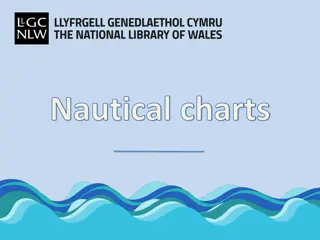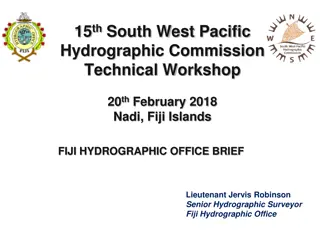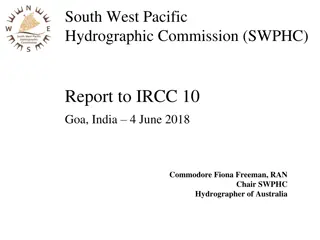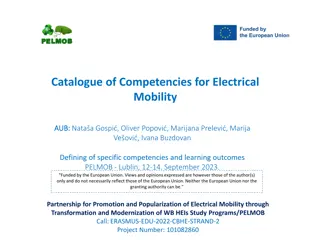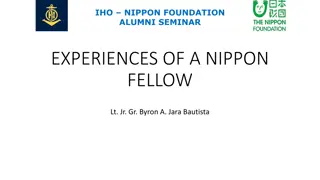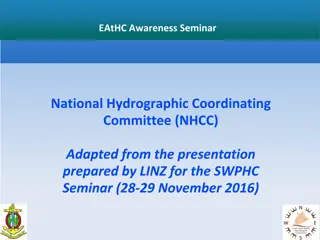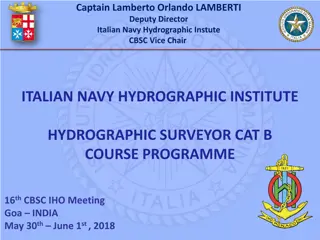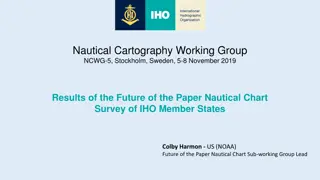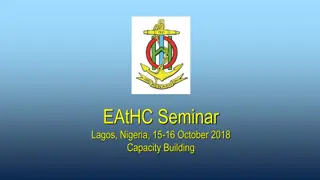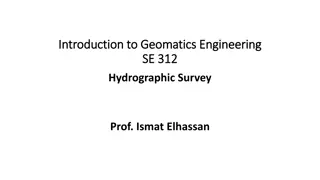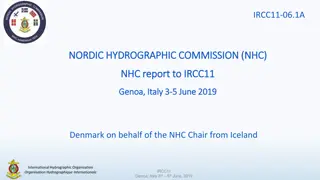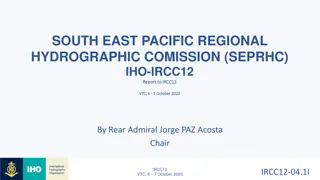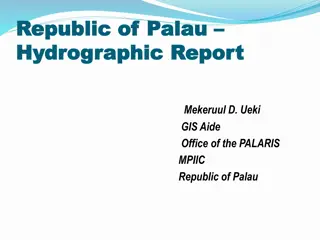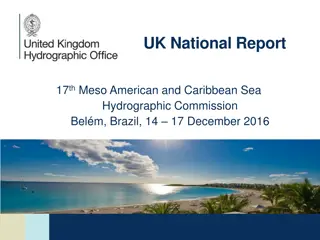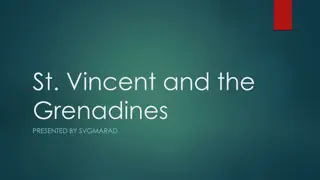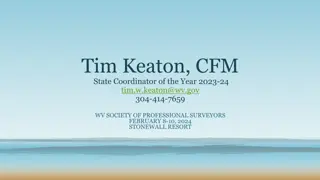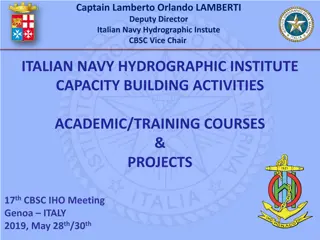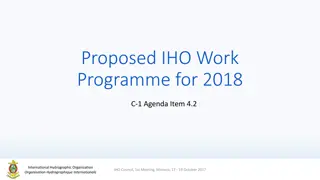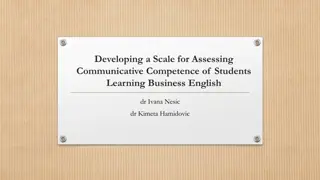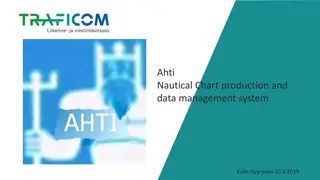Standards of Competence for Hydrographic Surveyors and Nautical Cartographers
This content discusses the standards of competence for hydrographic surveyors and nautical cartographers, including the roles of the board, new standards introduced, and sectors offering relevant programs. It covers the maintenance of standards by the board, details of new standards, educational program compliance, and sectors involved in program delivery. The information emphasizes the importance of meeting key competencies while adapting to varied demands in the field.
Download Presentation

Please find below an Image/Link to download the presentation.
The content on the website is provided AS IS for your information and personal use only. It may not be sold, licensed, or shared on other websites without obtaining consent from the author.If you encounter any issues during the download, it is possible that the publisher has removed the file from their server.
You are allowed to download the files provided on this website for personal or commercial use, subject to the condition that they are used lawfully. All files are the property of their respective owners.
The content on the website is provided AS IS for your information and personal use only. It may not be sold, licensed, or shared on other websites without obtaining consent from the author.
E N D
Presentation Transcript
The Standards of Competence for Hydrographic The Standards of Competence for Hydrographic Surveyors and Nautical Cartographers Surveyors and Nautical Cartographers Adam Greenland, IBSC Chair and Keith Miller, IBSC Board Member (Presented by Alberto Costa Neves, IBSC Secretary)
The Board The Board The Board maintains the standards and considers programs for recognition against the standards. 10 members (4 FIG, 4 IHO and 2 ICA), from government, education and industry; Members from New Zealand, Australia (2), Brazil, Greece, USA, UK, Portugal, Indonesia and Trinidad and Tobago
The Standards The Standards New standards: S-5A Standards of Competence for Category "A" Hydrographic Surveyors S-8A Standards of Competence for Category "A" Nautical Cartographers S-5B Standards of Competence for Category "B" Hydrographic Surveyors S-8B Standards of Competence for Category "B" Nautical Cartographers Accompanying document: Guidelines for the Implementation of the Standards of Competence for Hydrographic Surveyors and Nautical Cartographers Available from: www.iho.int/download
The Standards The Standards New standards (2): Replace S-5 and S-8. Educational programs found to be compliant with the standards are awarded recognition for a period of 6 years. Article published in the International Hydrographic Review (IHR), November 2017 Edition: https://www.iho.int/mtg_docs/com_wg/AB/AB_Misc/IHR-Nov-2017- Article-Standards.pdf
Sectors offering programs Sectors offering programs National agencies for management of territorial waters Civilian: labeled as Government Military: labeled as Defense Education Institutions offering degrees at Bachelors and Masters as well as diplomas. Industry programs delivered commercially or internally for staff development. Wide range of applications, many programs have a broad scope. Standards must be flexible in meeting the demands while ensuring coverage of key competencies.
Sectors offering programs Sectors offering programs
Sectors offering programs Sectors offering programs November 2018: 61 Recognized Programmes 2 Schemes 32 Countries:
Subjects in the Standards Subjects in the Standards S-5A Subjects S-5B Subjects S-8A Subjects S-8B Subjects B1 Mathematics, statistics, theory of observations B2 Information and Communication Technology B3 Physics B4 Nautical science B5 Meteorology F1 Earth Models F2 Oceanography F3 Geology and geophysics H1 Positioning H2 Underwater Sensors and Data Processing H3 LiDAR and Remote Sensing H4 Survey Operations and Applications H5 Water Levels and Flow H6 Hydrographic Data Acquisition and Processing H7 Management of Hydrographic Data H8 Legal Aspects COMPLEX MULTIDISCIPLINARY FIELD PROJECT B1 Mathematics, Statistics, Theory of Errors B2 Information and Communication Technology B3 Physics B4 Earth Sciences B5 Nautical science B6 Meteorology E1 Underwater Acoustics E2 Remote Sensing E3 Water Levels And Flow E4 Positioning E5 Hydrographic Practice E6 Hydrographic Data Management E7 Environment COMPREHENSIVE FINAL FIELD PROJECT B1 Mathematics, Statistics, Theory of Errors B2 Information and Communication Technology B3 Earth Sciences F1 General Geodesy F2 Hydrography and Nautical Products F3 Photogrammetry and Remote Sensing C1 General Cartography C2 Data for Nautical and Special Purpose Charting C3 Geospatial Information and Processing C4 Nautical Cartography C5 Legal aspects (Relating to nautical cartography) C6 Special Purpose Charting C7 Map/Chart Reproduction COMPREHENSIVE FINAL CARTOGRAPHIC PROJECT B1: Mathematics, Statistics, Theory of Errors B2: Information and Communication Technology B3: Earth Sciences E1: General Geodesy E2: General Cartography E3: Hydrography and Nautical Products E4: Data for Nautical and Special Purpose Charting E5: Photogrammetry and Remote Sensing E6: Geospatial Information and Processing E7: Nautical Cartography E8: Legal aspects (Relating to nautical cartography) E9: Special Purpose Charting E10: Map/Chart Reproduction COMPREHENSIVE CARTOGRAPHIC PROJECT Basic subjects cover general background principles and skills; Foundation subjects cover specialized subjects that have a scope beyond the standards. Essential subjects (Cat B) and specialist subjects (Cat A) relate directly to the discipline. Students may be exempted from Basic and Foundation subjects on the basis of prior learning.
Expressing competencies Expressing competencies Competencies are now specified in the standard format used in education as generic learning outcomes. Verbs such as specify , analyze , apply , select and identify indicate the depth of knowledge through a competency. Content is given to provide a context for the learning outcome.
Blooms taxonomy Bloom s taxonomy Used in education to express depth of learning. Remembering Define, describe, identify, list, ... Understanding Classify, report, discuss, demonstrate, ... Applying Apply, prepare, produce, implement, .. Analyzing Analyze, classify, compare, examine, .. Evaluating Assess, evaluate, justify, select, .. Creating Compose, design, develop, plan, .. There is some overlap, produce could be an application or a creation, select could be considered as an application or at the depth of evaluation.
Guidance on level Guidance on level An indication of the expected level is provided within the element, which is described as Advanced (A), Intermediate (I), or Basic (B). While describe and relate used H1.4a are remembering and applying, but the principles on which they are based are advanced. Similarly in elements C4.1a the verb outline alone implies remembering, but to achieve this in context of the content the level is considered as intermediate.
Number of outcomes Number of outcomes Subject type S-5B 49 - 118 - - 167 S-5A 62 49 - - 169 280 S-8B 34 - 191 - - 225 S-8A 38 35 - 164 - 237 Basic Foundation Essential Cartographic Science Hydrographic Science TOTAL A typical Masters program at a University might contain 70 learning outcomes, these are all academic. Competencies cover both academic knowledge and practical skills, many of the skills based learning outcomes in the standards require short delivery time and may be integrated within practical learning tasks.
Types of outcomes Types of outcomes Example skills based learning outcomes from S-5A: B4.9 - Specify procedures for deployment and recovery of oceanographic and hydrographic equipment. Students must be involved in equipment deployment and mobilization, this should not be done by technical support staff. F1.3e - Relate historical surveys to legacy positioning systems. Awareness that GNSS has not always existed, that historical data will not have the same accuracy that is available today. H2.1e - Use the sound speed profile to compute the path of sound ray through the water column. A detailed task that each student must perform. H2.4b - Tune acoustic parameters on-line for depth and backscatter. Can only be achieved through hands on practical work. Competencies cover academic requirements and include core skills that a Category A surveyor must have demonstrated, these typically form an integral part of practical work, hence more learning outcomes exist than expected of an academic program.
Program duration Program duration Guidelines that accompany the Standards specify: Maximum - The time frame over which an individual studies towards a recognized program cannot be more than five (5) years for a Category "B" Program and no more than six (6) years for a Category "A" Program. Minimum - In the experience of the Board, for a program (without exemptions sought) delivered full-time in a continuous manner an expected minimum time frame is. At Category "B", twenty four (24) weeks including the final project. At Category "A", forty (40) weeks, including the final project. Students are expected to be engaged for 50 to 60 hours per week over this duration to include lectures, practical work and guided study.
Final project Final project All standards require a comprehensive final project of at least 4 weeks in duration. Students must be involved in: Planning Preparation and Mobilization Data acquisition Data Processing Compilation of products and reporting. The project should be specified to incorporate a variety of equipment. Use of multi-beam in hydrography and multi-beam data in cartography are requirements.
Program submissions Program submissions Submitting organizations must fully document program structure, content and assessment strategy for both practical and theoretical components. Elements considered by the Board include: Level of assessment against expectations of specified learning outcomes. Content of lectures, practical tasks and other exercises that underpin the knowledge base to achieve the learning outcomes. Resources available for program delivery and assessment. Specifications and assessment criteria for assignment tasks and for the final field project.
Guidelines for submission Guidelines for submission Comprehensive guidelines are available to submitting organizations, these are continually being updated. A pro-forma cross reference table is provided that duplicates the standards with space for institutions to add modules and teaching hours associated with delivery and assessment. This must accompany detailed information on the program.
Evidence of learning Evidence of learning The Board needs reassurance that student learning is taking place at the required level, this is evidenced by: Past examination papers, even for new programs specimen papers are required. Specifications for practical tasks and assignments together with assessment criteria. Specifications for the final project with assessment criteria and previous student project reports where available. It is expected that there will be more than one form of assessment and that students will be assessed individually as well as in their group performance.
Quality assurance Quality assurance Evidence is required that internal quality assurance mechanisms are in place that maintain currency of content in practice and theory and address problems associated with logistics of delivery: Student progression criteria and remedial measures must be in place. Programs should be reviewed every 5 years, more frequently for new programs with feedback from staff, stakeholders and students being considered. Student exit surveys must be undertaken each year with a formal mechanism in place to immediately deal with reported problems that need urgent attention.
Submissions Submissions Must demonstrate that: Entry requirements are appropriate. A structured program exists with a plan for progression. Learning is taking place at the level specified in the standards. Scope of the intended learning outcomes is covered. Adequate time is given to theory and practice. Requirements given in the guidelines are met. It is up to the submitting organization to provide documentary EVIDENCE. Representatives are encouraged to attend the Board meeting to answer questions.
T Thanks from the IBSC hanks from the IBSC On behalf of the Board, I thank you for providing this opportunity to present the new standards. The Board acknowledges support from stakeholders in the region in providing feedback on drafts of the standards prior to their ratification. The Board looks forward to receiving further submissions for recognition from organizations offering education in hydrographic surveying and nautical cartography within the region. I will be pleased to answer questions now, during the breaks and afterwards.
Alberto Costa Neves IHO Assistant Director IBSC Secretary Email: alberto.neves@iho.int More information at: www.iho.int/ibsc and www.iho.int/cb
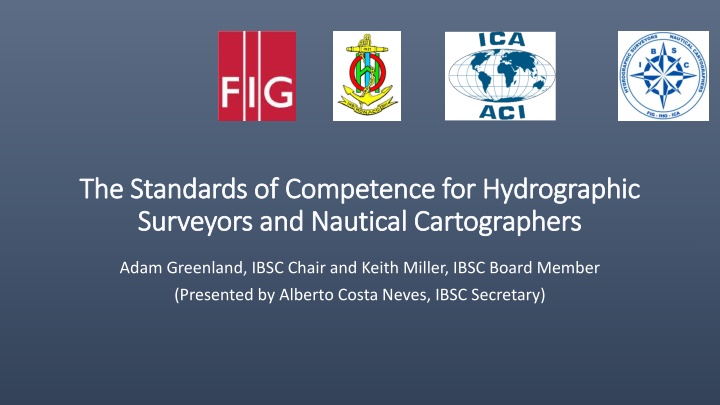

![[PDF⚡READ❤ONLINE] Solar Surveyors: Observing the Sun from Space (Springer Praxis](/thumb/21536/pdf-read-online-solar-surveyors-observing-the-sun-from-space-springer-praxis.jpg)
